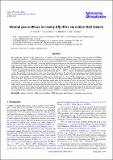Por favor, use este identificador para citar o enlazar a este item:
http://hdl.handle.net/10261/199302COMPARTIR / EXPORTAR:
 SHARE SHARE
 CORE
BASE CORE
BASE
|
|
| Visualizar otros formatos: MARC | Dublin Core | RDF | ORE | MODS | METS | DIDL | DATACITE | |

| Título: | Neutral gas outflows in nearby [U]LIRGs via optical NaD feature |
Autor: | Cazzoli, S.; Arribas-Mocoroa, Santiago CSIC ORCID ; Maiolino, R.; Colina, Luis CSIC ORCID | Palabras clave: | Galaxies: starburst ISM: jets and outflows ISM: kinematics and dynamics Techniques: spectroscopic |
Fecha de publicación: | jun-2016 | Editor: | EDP Sciences | Citación: | Astronomy and Astrophysics 590: A125 (2016) | Resumen: | We studied the properties of the neutral gas in a sample of 38 local luminous and ultra luminous infrared galaxies ([U]LIRGs, 51 individual galaxies at z ≤ 0:09), which mainly covers the less explored LIRG luminosity range. This study is based on the analysis of the spatially integrated and spatially resolved spectra of the NaDλλ 5890, 5896 Å feature obtained with the integral field unit (IFU) of VIMOS at the Very Large Telescope. Analyzing spatially integrated spectra, we find that the contribution of the stars to the observed NaD equivalent width is small (<35%) for about half of the sample, and therefore this feature is dominated by inter stellar medium (ISM) absorption. After subtracting the stellar contribution, we find that the pure-ISM integrated spectra generally show blueshifted NaD profiles, indicating neutral gas outflow velocities, V, in the range 65-260 km s. Excluding the galaxies with powerful AGNs, V shows a dependency with the star formation rate (SFR) of the type V ∝ SFR, which is in rather good agreement with previous results. The spatially resolved analysis could be performed for 40 galaxies, 22 of which have neutral gas velocity fields dominated by noncircular motions with signatures of cone-like winds. However, a large number of targets (11/40) show disk rotation signatures. Based on a simple model, we found that the wind masses are in the range 0.4-7.5 × 10 M, reaching up to ~3% of the dynamical mass of the host. The mass rates are typically only ~0.2-0.4 times the corresponding global SFR indicating that, in general, the mass loss is too small to slow down the star formation significantly. In the majority of cases, the velocity of the outflowing gas is not sufficient to escape the host potential well and, therefore, most of the gas rains back into the galaxy disk. On average V/v is higher in less massive galaxies, confirming that the galaxy mass has a primary role in shaping the recycling of gas and metals. The comparison between the wind power and kinetic power of the starburst associated with SNe indicates that only the starburst could drive the outflows in nearly all the [U]LIRGs galaxies, as the wind power is generally lower than 20% of the kinetic power supplied by the starburst. The contribution of an active galactic nuclei (AGN) is, in principle, significant in two cases. | Versión del editor: | http://dx.doi.org/10.1051/0004-6361/201526788 | URI: | http://hdl.handle.net/10261/199302 | DOI: | 10.1051/0004-6361/201526788 | Identificadores: | doi: 10.1051/0004-6361/201526788 e-issn: 1432-0746 issn: 0004-6361 |
| Aparece en las colecciones: | (CAB) Artículos |
Ficheros en este ítem:
| Fichero | Descripción | Tamaño | Formato | |
|---|---|---|---|---|
| Neutral_gas.pdf | 15,64 MB | Adobe PDF |  Visualizar/Abrir |
CORE Recommender
SCOPUSTM
Citations
60
checked on 10-abr-2024
WEB OF SCIENCETM
Citations
53
checked on 29-feb-2024
Page view(s)
182
checked on 23-abr-2024
Download(s)
159
checked on 23-abr-2024
Google ScholarTM
Check
Altmetric
Altmetric
NOTA: Los ítems de Digital.CSIC están protegidos por copyright, con todos los derechos reservados, a menos que se indique lo contrario.
